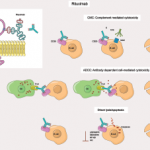Clinical manifestations of AAV may develop over the course of weeks or months and may vary in frequency and order of presentation. The frequency of organ involvement at the onset of GPA includes upper respiratory tract (93%), lower respiratory tract (55%), musculoskeletal (54%), kidney (61%), ocular (40%), skin (23%) and nervous system (21%), and may reach up to 99%, 85%, 75%, 77%, 61%, 46% and 40%, respectively, during the disease course.1
Patients with AAV may exhibit organ-specific manifestations, in addition to non-specific constitutional symptoms, such fatigue, fever, weight loss, myalgias and polyarthritis, which could be mistaken for cancer, infections or other autoimmune diseases.1
Our patient presented with migratory polyarthritis, which is reported in approximately 25% of patients with AAV; however, it is not pathognomonic and is rarely the initial presenting symptom.2
As a result of the various presentations of AAV and a broad differential diagnosis due to its multi-systemic nature, a delay in diagnosis frequently occurs and may lead to significant morbidity and mortality.
In one large study among patients with various systemic vasculitides, the median time to diagnosis of vasculitis was seven months and approximately 73% of patients were initially misdiagnosed.14
Common disorders that share clinical symptoms with AAV include other forms of systemic vasculitides; autoimmune disorders, such as RA, SLE, sarcoidosis, and IgG-4 related disease; various malignancies, including, but not limited to, nasopharyngeal carcinoma and lymphomas; and infections, particularly infective endocarditis, mycobacterial or fungal disease.
Our patient was misdiagnosed with palindromic rheumatism and possible early RA, which shares clinical features with AAV, such as episcleritis/scleritis, lung nodules/cavitary lesions, interstitial lung disease and subcutaneous nodules, in addition to polyarthritis.
Leukocytosis and/or thrombocytosis on complete blood counts (CBCs) are not uncommon. The presence of anemia can be due to chronic inflammation, renal disease or acute blood loss due to alveolar hemorrhage. Nonetheless, all these studies are not characteristic of AAV and may be found in many other conditions. Further, the presence of RF and ANA occur in 40% and 50% respectively of patients with AAV and other connective tissue disorders, infections, and malignancies, which may create confusion during evaluation and establishing diagnosis.15-17
Similar to a false positive RF test, a positive ANCA test must be carefully interpreted because, aside from AAV, it can also be caused by drugs (e.g., hydralazine, propylthiouracil, cocaine), infective endocarditis, IBD, autoimmune hepatitis, SLE, Sjögren’s disease and RA.18

